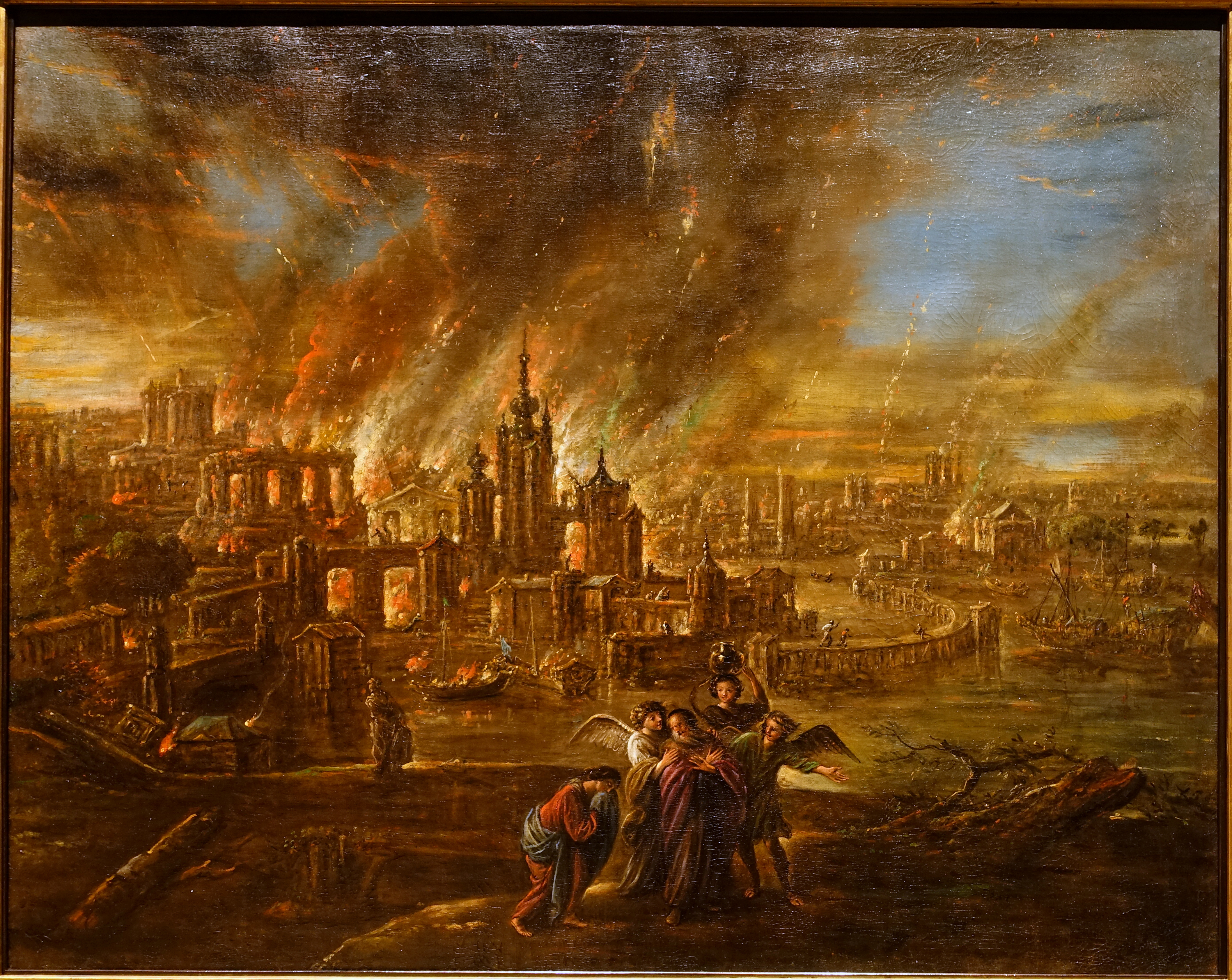The Sin of Sodom and Gomorrah – A Closer Look at What The New & Old Testament And Jewish Historians Reveal About It.
Sodom and Gomorrah – “Abomination”
Sodom and Gomorrah were cities in the fertile Jordan River plain, which the Book of Genesis compares to the Garden of Eden. Their description as a lush region is a key part of the biblical account, of their destruction by God due to the inhabitants’ wickedness.

It is important to note that in that arid and dessert region, Sodom and Gomorrah (and the 5 cities in that plain) where few and far between. Imagine in ancient times a traveler, sojourning in a dusty desert plain, with very limited vegetation and even more scarce was water for both people and their camels / donkeys / sheep etc. that traveled with them as a means of survival.
Based on Jewish rabbinic tradition and other scriptural commentaries, the people of Sodom and Gomorrah had cruel and wicked customs that punished or forbade kindness to weary travelers.
While the biblical Book of Genesis does not explicitly detail these laws, later Jewish commentaries known as the Midrash fill in the story with specific examples of the city’s extreme in-hospitality and injustice.
Examples of the laws and customs
The “Bed of Sodom”: According to the Midrash, the Sodomites would give weary travelers a bed to sleep on. If the person was too short, they would stretch them to fit the bed. If they were too tall, they would cut off their feet. This illustrates the city’s cruel and perverse lack of hospitality.
The Mark on a Coin: One custom involved giving marked coins to beggars. Though the citizens appeared charitable, they forbade the merchants from accepting the coins. The beggar would eventually die of starvation, and the citizens would reclaim their money.
Punishment for Generosity: Midrashic accounts tell of a young woman who was burned to death for secretly giving a piece of bread to a poor, starving man. Her cry reached God, becoming part of the “outcry” mentioned in Genesis.
Not only was it the laws of Sodom and Gomorrah dictating that the people show no charity or mercy to the stranger, the traveler or the poor within its gates and walls, it was cause for civic duty and a badge of honour to be seen or to be know as a citizen that would by law, and by pride , demonstrate depraved indifference to the suffering of non citizens and the poor and suffering born into their lush garden cities. Being a lush and fertile plain in the midst of so much desert terrain and being well known through out the ages for having nomadic peoples, there was perhaps to a certain degree a reasonable amount of concern as to keeping it’s population numbers and outsiders in check in an effort to maintain a sustainable region. That being said the people of the 5 cities in that plain made an art form as it where of how to be viciously unkind to those without..

Biblical and prophetic context
In the biblical account, Lot’s offers hospitality to two visitors is met with violent opposition from the men of Sodom. When the mob demands that Lot hand over his guests “that we may know them,” it is seen by many scholars not as a sexual act, but as a demand to interrogate or brutalize them. This in-hospitality and brutality is what truly offends God, it is an Abomination to Him..
This view is supported by later Hebrew prophets who cite Sodom’s sins. For instance, the prophet Ezekiel (Ezekiel 16:49 – 16:50) points to their pride, excess of food, and selfishness amidst their prosperity, stating that they “did not aid the poor and needy”.
Jesus also references Sodom’s in-hospitality in Matthew 10, stating that it will be more tolerable for Sodom on the day of judgment than for towns that reject his disciples.
In this Chapter of Matthew the disciples where sent out two by two, they where instructed to take no form of money with them or to even pack along with them a change of clothes. Their shelter and food was to come as an act of charity (which is love) from those whom they came to minister to in the preaching of The Kingdom of Heaven and to .”Heal the sick, cleanse the lepers, raise the dead, cast out devils:”
14 And whosoever shall not receive you, nor hear your words, when ye depart out of that house or city, shake off the dust of your feet.
15 Verily I say unto you, It shall be more tolerable for the land of Sodom and Gomorrha in the day of judgment, than for that city.
16 Behold, I send you forth as sheep in the midst of wolves: be ye therefore wise as serpents, and harmless as doves.
17 But beware of men: for they will deliver you up to the councils, and they will scourge you in their synagogues;
18 And ye shall be brought before governors and kings for my sake, for a testimony against them and the Gentiles.
Just as two Angles went to the House of Lot to save him and his house hold, to spare them from death and destruction so too did the disciples go to the homes of the people to do just as such.
Jesus knew and told them that some of the people would not receive them in charity / love but would turn them over to the authorities, to be held to the religious / civil laws, and just like the citizens of Sodom and Gomorrah it would be for them a duty to turn them in as good Jews and Roman citizens to do so and surely in their eyes and the eyes of the authorities they would have been esteemed for doing the “right thing” according to them keeping in mind the disciples only would seek a nominal amount of food, water, and shelter while they performed miracles among the people.
Again it was cruel and depraved for those who did so to do so, and to Jesus and God our Father in Heaven it was an offense, an Abomination.
The most common ancient Hebrew root word associated with “Abomination” is shâqats (שָׁקַץ), meaning “to be filthy,” “to loathe,” or “to abhor”.

This examination is on the matter of is not the sin of Sodom one of sexuality / homosexuality?
Yes, it is, in part.
The word “sodomy,” was first used by an English clergyman to describe Homosexual male intercourse. This of course stemmed from Genesis 19:1 – In particular is verse 8 “Behold now, I have two daughters which have not known man; let me, I pray you, bring them out unto you, and do ye to them as is good in your eyes: only unto these men do nothing;…” This was Lot’s response to 5 And they called unto Lot, and said unto him, Where are the men which came in to thee this night? bring them out unto us, that we may know them.
For most of the gentile Christians, its Clergy and Theologians it seemed clear and right to infer that the men of Sodom ” both old and young”, that surrounded Lot’s house and tried to break down the door to get to the two angles (that appeared in the form of men) for reasons of a sexual nature.
This could well have been the case. It as I said seemingly it is clear in Judaeo / Christian teachings that Lot having been living among the people of Sodom rushed to spare the men (Angels) from being sodomized and in their stead he offered his two virgin daughters to appease them. This calls into consideration that if in fact Lot knew they wanted the men (Angles) for sexual purposes that the men of Sodom where not just homosexual but Bi-Sexual as evidenced by the offering of two women to the men of Sodom.
Since Lot’s daughters where virgins it is seemingly reasonable to conclude that at least for Lot and his family that sexual assault was seemingly not a insurmountable threat for or to them up until that point from what the scriptures reveal.
Knowing that the citizens of Sodom where under the laws and customs of Sodom they could well have wanted the Angles to come out so that they could interrogate them, to determine if they where vagrants, nomads, if they had any means of paying to meet their needs (or not), and if they planned to stay for any length of time. It could well have been that they where looking to do what for them was a civic duty and make the Angles stay inhospitable using the cruel customs that they where encouraged to employ against the stranger / traveler and the poor.
If that was the case Lot’s offer of his two virgin daughters could well have been a ransom for the Angles lives, a way to appease or distract the mob from more than sexually assaulting them.

Why it is generally though that the men of Sodom sought the angles for sexual reasons is the phrase ” that we may know them”. Biblically speaking to come to know some one is a well-known biblical usage of “know” or “knew” as a euphemism for sexual intercourse.
This euphemism is in deed original to the Hebrew texts (The Torah as written by Moses); it was not introduced by later translators. The Hebrew root is ידע yāda`, which covers a semantic field similar to that of English to know.
List of Bible Verses Where “Know” or “Knew” Refers to Sexual Relations
– Genesis 4:1
And Adam knew Eve his wife; and she conceived, and bare Cain, and said, I have gotten a man from the LORD.
– Genesis 4:17
And Cain knew his wife; and she conceived, and bare Enoch: and he builded a city, and called the name of the city, after the name of his son, Enoch.
– Genesis 4:25
And Adam knew his wife again; and she bare a son, and called his name Seth: For God, said she, hath appointed me another seed instead of Abel, whom Cain slew.
– Genesis 24:16
And the damsel was very fair to look upon, a virgin, neither had any man known her: and she went down to a well, and filled her pitcher, and came up.
– Genesis 38:26
And Judah acknowledged them, and said, She hath been more righteous than I; because that I gave her not to Shelah my son. And he knew her again no more.
– Numbers 31:17
Now therefore kill every male among the little ones, and kill every woman that hath known man by lying with him.
– Numbers 31:18
But all the women children, that have not known a man by lying with him, keep alive for yourselves.
– Numbers 31:35
And thirty and two thousand persons in all, of women that had not known man by lying with him.
– Judges 11:39
And it came to pass at the end of two months, that she returned unto her father, who did with her according to his vow which he had vowed: and she knew no man. And it was a custom in Israel,
– Judges 19:25
But the men would not hearken to him: so the man took his concubine, and brought her forth unto them; and they knew her, and abused her all the night until the morning: and when the day began to spring, the men let her go.
– 1 Samuel 1:19
And they rose up in the morning early, and worshipped before the LORD, and returned, and came to their house to Ramah: and Elkanah knew Hannah his wife; and the LORD remembered her.
– 1 Kings 1:4
And the damsel was very fair, and cherished the king, and ministered to him: but the king knew her not.
– Matthew 1:25
And knew her not till she had brought forth her firstborn son: and he called his name JESUS.
– Luke 1:34
Then said Mary unto the angel, How shall this be, seeing I know not a man?
This above scriptural citations make a compelling case to interpret and conclude that Genesis 19:1 is in reference to homosexuality / bi sexuality in relation to the angles and the use of the word / phrase “know” to wit, to God as written in the scriptures is an abomination as per Leviticus 20:13.
1And there came two angels to Sodom at even; and Lot sat in the gate of Sodom: and Lot seeing them rose up to meet them; and he bowed himself with his face toward the ground;
6 And Lot went out at the door unto them, and shut the door after him,
7 And said, I pray you, brethren, do not so wickedly.
As written by Gods Prophet Ezekiel, Sodom’s core sins lay in its lack of hospitality, its brutality, and its distortion of justice—rather than just sexuality alone. He writes and account of the city as haughty and indifferent to others’ suffering. Its inhabitants enjoyed abundant food in a walled, protected garden city where they lived at ease, but they wickedly withheld charity / loving kindness from the impoverished and vulnerable, including travelers and strangers such as where the Angles sent to them by God.
Ezekiel 16:49 – 16:50
Furthermore and most importantly Jesus as demonstrated by his own words and as written in the gospel according to Matthews witness was in deed an abomination.
So the next time you think of the sin of Sodom and Gomorrah keep in mind it is far more than just a euphemism reserved for sexual morality, but a depraved indifference, and the decided practice, custom, and disposition both in the heart, mid, and spirit of some people to not love one another as themselves. .
Matthew Chapter 22:36-41
36 Master, which is the great commandment in the law?
38 This is the first and great commandment.
39 And the second is like unto it, Thou shalt love thy neighbour as thyself.
40 On these two commandments hang all the law and the prophets.
41 While the Pharisees were gathered together, Jesus asked them,
1 Peter 4:8 “And above all things have fervent love among yourselves: for lave shall cover the multitude of sins.”
I hope that in reading this you have learned something perhaps new and or that it serves as a reminder of what is an abomination to God and that Love (Agape) covers a multitude of sins and it is the greatest commandment of all.
Agape is “the highest form of love, charity” and “the love of God for mankind and of mankind for God”.
Rev. J.Mc.
Notes and References:
Abomination: Three Hebrew words connote abomination: תּוֹעֵבָה (toʿevah), שֶׁקֶץ (shekeẓ, sheqeẓ) or שִׁקּוּץ (shikkuẓ, shiqquẓ), and פִּגּוּל (piggul); toʿevah is the most important of this group. It appears in the Bible 116 times as a noun and 23 times as a verb and has a wide variety of applications, ranging from food prohibitions (Deut. 14:3), idolatrous practices (Deut. 12:31; 13:15), and magic (Deut. 18:12) to sex offenses (Lev. 18:22 ff.) and ethical wrongs (Deut. 25:14–16; Prov. 6:16–19). Source: JewishVirtualLibrary.org
. The English term translates several distinct Hebrew words that refer to different types and degrees of acts that are profoundly detestable to God.
-
-
t−−bt minus negative b
𝑡−−𝑏
(ת־ע־ב)
-
š−q−š minus q minus
š−𝑞−
(ש־ק־ץ)
-
𝑡−−𝑏
(ת־ע־ב)
-
- Root meaning: To be disgusting or abhorrent.
- Context of use: Tōʿēḇâ describes a wide range of detestable actions and practices, emphasizing moral and ethical corruption. Examples include:
-
- Idolatry and the worship of false gods.
- Incest and other illicit sexual acts.
- Cheating in the market with dishonest weights and measures.
- Pride, lying, and evil schemes.
-
- Cultural taboos: The term can also refer to things that are socially or ritually repulsive. For example, in Genesis, the text notes that shepherds were a tōʿēḇâ to the Egyptians.
š−𝑞−
(ש־ק־ץ)
-
- Root meaning: To be filthy or loathsome.
- Context of use: These words are often used in a ritual or cultic sense to describe things that are spiritually unclean and detestable. Examples include:
-
- Forbidden “unclean” animals, such as certain sea creatures, insects, and birds.
- Idolatrous objects and pagan religious practices.
- In the Book of Daniel, šiqqûṣ is used in the phrase “the abomination that causes desolation,” referring to the desecration of the temple.
-
“Midrashic” describes something related to midrash, a Jewish form of biblical exegesis that interprets, elaborates on, and gives deeper meaning to scriptural texts. It can refer to the exegetical method itself, which uses rabbinic interpretation to find hidden significance in the Bible, or to the compilations of such homilies and commentaries that were composed over centuries, like the Midrash Rabbah. The term implies the tradition of seeking the “true meaning” of scripture by seeking and studying the text with care.
Key Aspects of Midrashic Interpretation
Elaboration and Embellishment:
Midrashic works often embellish the biblical narrative, providing rich commentary and adding details to the text.
Traditional Jewish Methods:
This interpretation uses specific rabbinic methods of analysis and commentary, seeking to make the ancient texts relevant to contemporary life.
Halakhic and Haggadic Material:
Midrash includes both Halakhic (legal) and Haggadic (homiletic, non-legal) materials.
Finding Deeper Meaning:
It aims to uncover deeper insights by reading distant biblical verses in relation to each other, revealing a richer, multifaceted understanding of the text.
Body of Writings:
“Midrashic” can also refer to the expansive body of literature containing these interpretations, which began as oral tradition and was compiled into writings from late antiquity.
In essence, to be “midrashic” is to operate in the spirit of midrash: to explore the biblical text deeply, drawing out its layered meanings through study, prayer, contemplation, and traditional exegetical methods.

